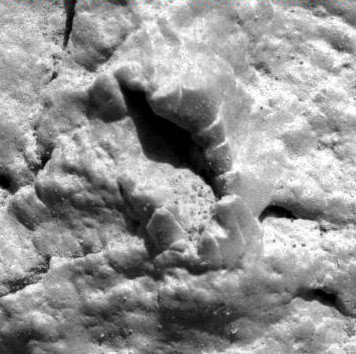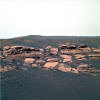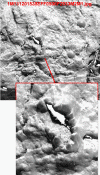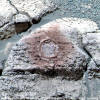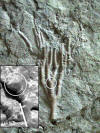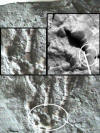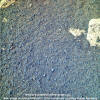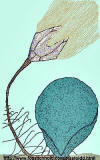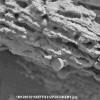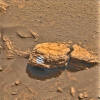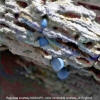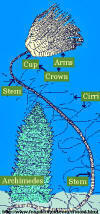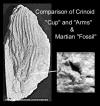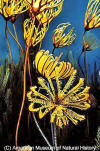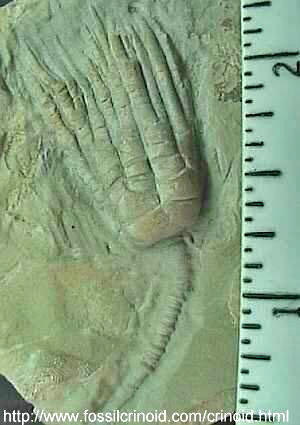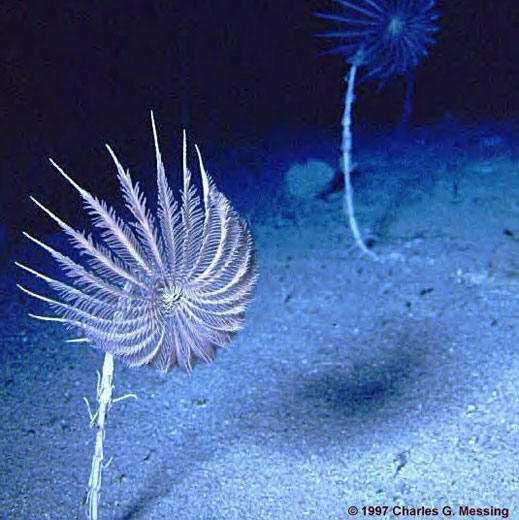|
The overall, few inches high outcrop, which spans approximately 180 degrees of the crater's interior, has been dubbed by the JPL Rover Team "Opportunity Ledge."
The specific section that
Opportunity was ordered to investigate last week is about
in the middle of this outcrop (left), is approximately ten i
Preparatory to actually drilling into El Capitan and making detailed composition measurements with the array of sophisticated instruments on the Rover's "arm," Opportunity was commanded to take a series of close-up Microscopic Images of the untouched surface of the rock with the B&W CCD camera attached to the arm.
One of those images (1M131201699EFF0500P29933M2M1.jpg) revealed an amazing sight (right).
A potential Martian
fossil !
The
raw "before" and "after" images of this
wanton and inexplicable destruction can still be seen at the
JPL Mars
Exploration Rover Mission homepage. Quoting from one correspondent, James Calhoun:
The images Jim included
with his e-mail "knocked our socks off," as the saying goes.
Chosen from "A Beginners Guide To Identifying Cincinnatian Crinoids," by Jack Kallmeyer, they clearly showed that the fossilized Martian "creature" we'd discovered on this series of Opportunity's Microscopic Images for Sol 33, shared an amazing number of specific characteristics with one "Ordovician Crinoid Retercrinus Alvealatus" (rigth-top).
Other images Mr. Calhoun sent us revealed even further similarities (right-bottom).
Among the many responses to our posting of this extraordinary terrestrial fossil analog, was one from our long-time friend and colleague, Ron Nicks. Ron, as you may remember, is one of our Enterprise consulting geologists, who's written a number of thoughtful analyses on prior NASA missions and results.
For several days prior to this, Ron and I had been arguing back an forth via e-mail about the "Martian blueberries" that Jim Calhoun alluded to - those curiously spherical, highly uniform "somethings" that litter the Opportunity crater... literally, in the millions.
As seen in this PanCam color image (left), not only are these mysterious objects amazingly abundant and apparently contained within the rocks (until released through slow erosion), in properly calibrated images they are actually blue (contrary to the Rover Science Team Principal Investigator Stephen Squyres' increasingly curious denials at NASA press conferences, "They're NOT blue..." - after it was he who originally termed them "blueberries"...).
In fact, other than noting their great profusion and color, the major
mystery of "what are they, really?" - the most obvious "anomalous features"
of this entire Martian landscape - had not been publicly addressed directly
by the Rover Science
Ron had been arguing that the "berries" were also some kind of preserved life form, specifically representative of a separate Class of marine invertebrate animals (now extinct on Earth) called "blastoids." Fossilized blastoids (commonly called "fossil Rose Buds" or "Hickory Nuts" in the southeastern United States - where a lot of their fossils have been found) at first glance resemble a hard fruit common to many current trees.
In fact, they are the partially petrified remains of a marine organism which (like the Crinoids– see left) stood above the sea floor on a long, segmented "stem" and gathered food from the surrounding currents with a waving set of tentacles (rarely preserved) called "pinnules" (left)
One common blastoid form, because of its striking five-sided symmetry (left-fig.2), is called "Pentremites."
When Opportunity rolled up and took its first close in PanCam color images of a feature of "Opportunity Ledge" called "Stone Mountain" (right-fig.4), the spacecraft was also commanded to acquire Microscopic Images at the same time (right-fig.1)
Notice on the MI image (left-fig.3), the series of extremely thin, parallel, sedimentary layers in this rocky outcrop (1M129516156EFF0312P2933M2M1.jpg), which also includes a couple of dangling "Martian blueberries," partially exposed.
Ron, in examining the "blueberries" on several of these and other close-ups, believed he'd spotted the tell tale, five-sided signature of Pentremites!
In a carefully composited color version of this same image, created by another Enterprise associate, Jill England, the details of some "berries" become clear. As you enlarge the "berries," distinct hints of five-sided, geometric surface features - eerily similar to fossilized terrestrial blastoids - finally do appear (right).
Though eroded by unknown length of exposure to the Martian winds and sands - which over time have almost removed all
Based on his paleontological experience, Ron had been arguing for days that
these tantalizing clues pointed to a fossil explanation for the
While intrigued, I was not convinced....
Then, I found the fossil on the Sol 33 Rover MI image, and posted it on Enterprise. James Calhoun's highly provocative confirmatory e-mail and images arrived.
And, Ron wrote again:
Crinoids first appeared in Earth's primeval seas over 500 million years ago, in the so-called "Cambrian Era," climbing to dominance over the next 150 million years, before receding once again in the terrestrial fossil record.
The section of our fossilized Martian equivalent - apparently captured in the Opportunity Microscopic Image from Sol 33 - was the base of the "cup" and a small portion of one segmented "arm" (compare images left and right).
The other arms, which were used to gather food from the underwater ocean currents when the organism was alive, apparently had eroded away (or been blasted away by the creation of this Martian crater)... long before NASA's Opportunity Rover landed in the crater and took the specific image....
The mysteries presented by this astonishing discovery are far too complex to even begin to explore in any depth here. But a few questions seem in order...
Given that this is real, that all of us now who have independently looked at
this, and come to the same conclusion - that this could in fact be a
genuine Martian fossil at Maridiani Planum - are not delusional... what
could it mean?
While refraining from also claiming that "Opportunity
Ledge's" layers of sediments had been laid down in actual liquid water,
they came very close... and hinted that this confirmation could come "as
early as a few days."
If you look at a combined map of where JPL landed its two Rovers, and the Odyssey GRS orbital determination of water abundance in the upper one meter of Martian soil, a glance will suffice to show the Rovers are indeed exploring none other than the shallows of our two proposed equatorial Martian tidal oceans (right)! Almost as if that had been planned...
The fact that our small Martian creature seems identical to the Crinoids which once dominated Earth's terrestrial oceans is astounding. That fact alone - if it is a fact - means that something is radically wrong with our current view of biological, if not planetary, evolution.
Verifying that simple fact would seem now to be the highest priority for a space program about to undertake significant new challenges… including multi-generational planning for human flights to Mars.
It is so easy to invoke the idea of "parallel evolution" to explain this
astonishing development. But is such a concept - especially on two totally
different planets, with totally differing environments and histories - even
plausible science fiction… let alone scientific fact? Could not one just as
easily invoke the intervention of an "outside agency" - including a
Creator - to explain the appearance, on these two separate worlds, of a species
essentially identical in function and in form...?
As a result, his "Mars" in the new novel was highly praised, by both veteran science fiction writers and planetary scientists alike, as "totally authentic."
One wrote:
... four years ago?!
|
